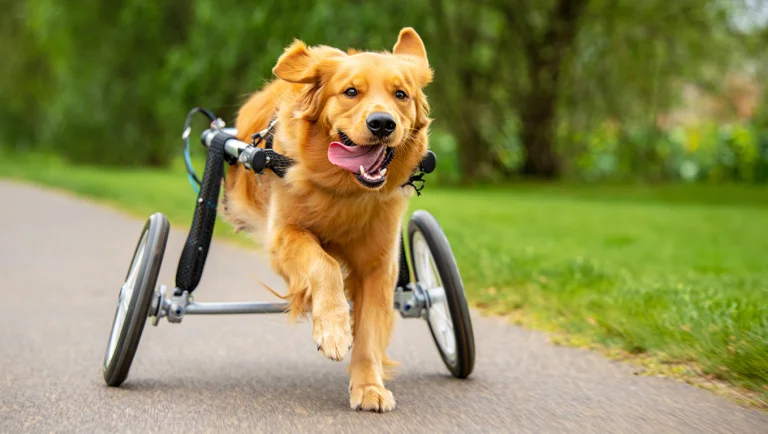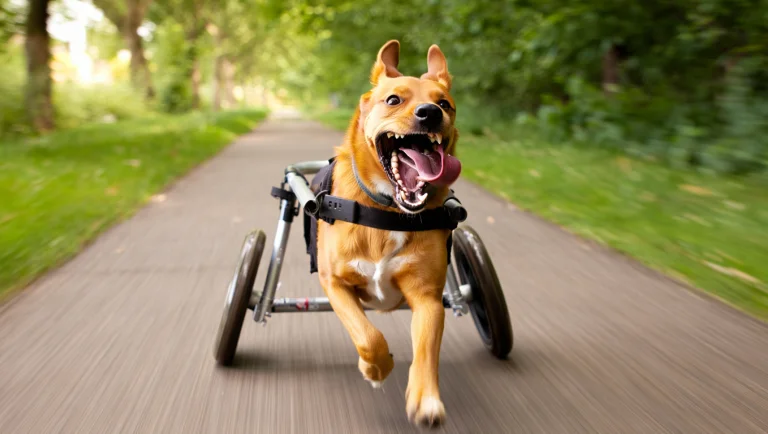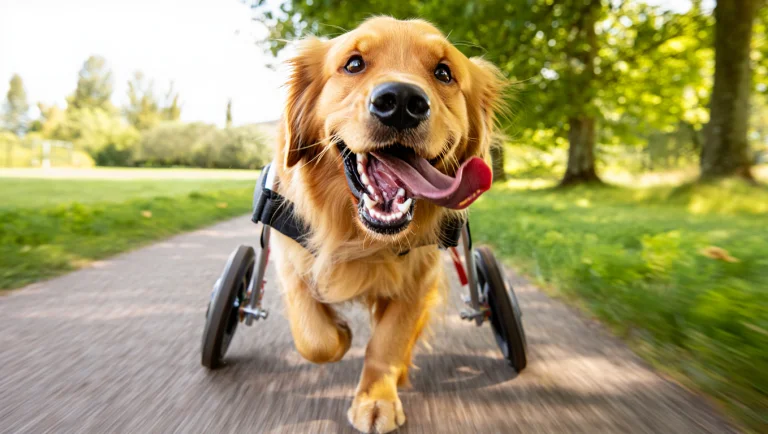Discover the best dog wheelchairs for mobility issues in our comprehensive guide covering types, benefits, and top products to help your furry friend regain independence.
Table of Contents
When our furry companions face mobility challenges, watching them struggle can be heartbreaking. Dog wheelchairs have revolutionized the lives of pets with mobility impairments, allowing them to regain independence and joy. Whether due to aging, injury, or congenital conditions, a properly fitted dog wheelchair can dramatically improve your pet’s quality of life. This comprehensive guide explores everything you need to know about dog wheelchairs—from understanding when your pet needs one to selecting the perfect model for their specific needs.
What Are Dog Wheelchairs and How Do They Work?
Understanding Canine Mobility Devices
Dog wheelchairs, also called pet mobility carts, are assistive devices designed to support dogs with limited or no use of their hind legs, front legs, or all four limbs. These specialized devices provide structural support while allowing dogs to move using their functional limbs.
Types of Dog Wheelchairs
Dog wheelchairs come in several configurations based on a pet’s specific needs:
- Rear Support Wheelchairs: The most common type, these support dogs with hind leg weakness or paralysis due to conditions like degenerative myelopathy, spinal injuries, or hip dysplasia.
- Front Support Wheelchairs: These assist dogs with front limb impairments, such as those caused by neurological conditions or amputations.
- Quad/Full Support Wheelchairs: Designed for dogs with weakness in all four limbs, these provide comprehensive support for conditions like advanced degenerative myelopathy or severe arthritis.
- Adjustable Wheelchairs: These versatile options can be modified as a dog’s condition progresses or changes.
Core Components of Dog Wheelchairs
A quality dog wheelchair typically includes:
- Frame: Usually made from lightweight, durable materials like aluminum or PVC
- Wheels: Designed for various terrains and sized appropriately for the dog
- Harness System: Supports the dog’s body while distributing weight evenly
- Connecting Hardware: Allows for adjustments to fit the dog’s specific dimensions
- Padding: Prevents rubbing and ensures comfort during extended use

Signs Your Dog May Need a Wheelchair
Mobility Decline Indicators
Watch for these signs that might indicate your dog could benefit from a wheelchair:
- Progressive difficulty standing up or maintaining balance
- Dragging hind legs when attempting to walk
- Decreased willingness to participate in previously enjoyed activities
- Muscle atrophy in the legs
- Inability to support their own weight
- Frequent falling or collapsing during movement
- Visible frustration when trying to move
Common Conditions That May Require Wheelchair Support
Several medical conditions can lead to the need for mobility assistance:
- Degenerative Myelopathy: A progressive disease of the spinal cord that causes gradual paralysis, particularly common in German Shepherds, Corgis, and Boxers.
- Intervertebral Disc Disease (IVDD): Often affecting Dachshunds, Beagles, and Basset Hounds, IVDD can cause sudden or gradual paralysis.
- Hip Dysplasia: This developmental condition affects hip joint formation and can lead to severe mobility limitations, especially in larger breeds.
- Arthritis: Advanced arthritis can significantly impair mobility in aging dogs.
- Amputation Recovery: Dogs recovering from limb amputation often benefit from temporary wheelchair support.
- Neurological Disorders: Conditions like wobbler syndrome or fibrocartilaginous embolism can impact mobility.
- Spinal Injuries: Trauma to the spine can result in temporary or permanent paralysis.
Benefits of Dog Wheelchairs for Dogs with Mobility Issues
Physical Benefits
- Restored Mobility: The primary benefit is giving dogs back their ability to move independently.
- Muscle Maintenance: Regular movement helps prevent muscle atrophy in functional limbs.
- Improved Circulation: Standing and moving position promotes better blood flow compared to lying down continuously.
- Digestive Health Support: Upright positioning facilitates better digestive function and can reduce complications from extended bed rest.
- Respiratory Support: Standing position allows for improved lung expansion, particularly beneficial for older dogs.
Psychological Benefits
- Maintained Independence: Dogs retain their ability to explore and navigate their environment.
- Reduced Frustration: Eliminating the struggle to move can significantly decrease stress and anxiety.
- Continued Social Interaction: Mobile dogs can continue to participate in family activities and outings.
- Mental Stimulation: Mobility enables environmental exploration, providing crucial mental engagement.
- Quality of Life: Perhaps most importantly, wheelchairs can dramatically improve a dog’s overall happiness and zest for life.

How to Choose the Right Dog Wheelchair
Essential Measurements
Selecting the correct wheelchair starts with accurate measurements:
- Weight: Influences the frame strength and wheel size needed
- Height: Measured from the floor to the top of the hip or shoulder, depending on wheelchair type
- Length: From chest to base of tail
- Width: Across the widest part of the chest or hips
- Leg Clearance: Distance from ground to lowest part of functional limbs
Critical Features to Consider
When evaluating dog wheelchair options, prioritize these features:
- Adjustability: Look for models with multiple points of adjustment to accommodate growth or changes in condition.
- Weight of the Device: Lighter frames reduce fatigue, especially important for smaller dogs.
- Terrain Compatibility: Consider where your dog will primarily use the wheelchair—indoors, grass, pavement, or varied terrain.
- Ease of Use: Evaluate how quickly you can put on and remove the wheelchair, as this affects daily practicality.
- Durability: Materials should withstand daily use and occasional impacts.
- Comfort Features: Padding at contact points and harness quality significantly impact your dog’s comfort.
- Bathroom Accommodation: Ensure the design allows your dog to relieve themselves while wearing the wheelchair.
Top Dog Wheelchairs on the Market in 2025
For Small Breeds (Under 25 lbs)
- Walkin’ Wheels Small Dog Wheelchair
- Key Features: Highly adjustable frame, lightweight aluminum construction, comes with training materials
- Best For: Dachshunds, Corgis, and other small breeds prone to IVDD
- Price Range: $249-$329
- Best Friend Mobility Small Dog Wheelchair
- Key Features: Excellent for indoor navigation, comfortable neoprene padding, quick-release mechanisms
- Best For: Indoor pets and dogs needing frequent wheelchair breaks
- Price Range: $189-$269
For Medium Breeds (25-50 lbs)
- K9 Carts Medium Rear Support Wheelchair
- Key Features: Veterinarian-designed frame, custom-fitting available, all-terrain wheels
- Best For: Active medium-sized dogs that enjoy outdoor adventures
- Price Range: $299-$399
- HiHydro Dog Wheelchair
- Key Features: Budget-friendly option with good adjustability, lightweight frame
- Best For: Temporary rehabilitation or occasional use
- Price Range: $135-$215
For Large Breeds (Over 50 lbs)
- Eddie’s Wheels Large Dog Cart
- Key Features: Custom-built for each dog, exceptional durability, balanced weight distribution
- Best For: Large breed permanent mobility solutions
- Price Range: $455-$700+
- Walkin’ Wheels Large Dog Wheelchair
- Key Features: Foldable for transport, foam-filled tires that never go flat, adjustable frame
- Best For: Active large dogs, particularly those still participating in family outings
- Price Range: $399-$549
For Special Needs
- Quad4Paws Full Support System
- Key Features: Four-wheel support system for dogs with limited mobility in all limbs
- Best For: Dogs with neurological conditions affecting all legs
- Price Range: $675-$950
- Adjustable Front Wheel Attachment
- Key Features: Add-on to convert rear support wheelchairs to full support
- Best For: Progressive conditions where mobility needs change over time
- Price Range: $199-$299 (attachment only)

Transitioning Your Dog to Using a Wheelchair
First-Time Use Tips
Introducing your dog to their wheelchair should be a gradual, positive experience:
- Familiarization Period: Allow your dog to sniff and investigate the wheelchair before attempting to use it.
- Positive Association: Use treats and praise to create positive associations with the wheelchair.
- Short Sessions: Begin with 5-10 minute sessions, gradually increasing duration as your dog becomes comfortable.
- Level Terrain: Start on flat, open spaces without obstacles or distractions.
- Support Presence: Stay close to provide reassurance and physical support if needed.
Training Progression
A systematic approach helps most dogs adapt quickly:
- Static Fitting: First, get your dog comfortable with wearing the harness without movement.
- Assisted Movement: Support your dog while they take their first steps, guiding the wheelchair direction.
- Independent Short Distances: Let your dog attempt short, straight paths independently.
- Introducing Turns: Once comfortable moving forward, practice gentle turns and direction changes.
- Adding Terrain Variations: Gradually introduce different surfaces like grass, carpet, and pavement.
- Extending Duration: Slowly increase the time spent in the wheelchair as your dog builds endurance.
Care and Maintenance of Dog Wheelchairs
Daily Care
Proper maintenance ensures comfort and extends the wheelchair’s lifespan:
- Harness Inspection: Check daily for signs of rubbing, chafing, or pressure points on your dog’s skin.
- Cleaning: Wipe down the frame and wash harness components regularly according to manufacturer instructions.
- Wheel Maintenance: Remove hair, debris, and dirt from wheels and axles after outdoor use.
- Hardware Check: Verify that all bolts, screws, and fasteners remain secure before each use.
Long-Term Maintenance
Regular comprehensive maintenance prevents larger issues:
- Wheel Alignment: Check and adjust wheel alignment monthly to ensure smooth movement.
- Frame Inspection: Examine the frame for cracks, bends, or stress points quarterly.
- Padding Replacement: Replace worn padding or harness components as needed, typically every 6-12 months.
- Lubrication: Apply appropriate lubricant to moving parts according to manufacturer recommendations.
- Professional Assessment: Consider annual professional fitting reassessment, especially for growing dogs or changing conditions.
Living with a Dog in a Wheelchair
Home Modifications
Creating a wheelchair-friendly environment helps your dog navigate confidently:
- Clear Pathways: Remove obstacles and create wide paths throughout your home.
- Non-Slip Surfaces: Add rugs or runners on slippery floors to provide traction.
- Ramps: Install gentle-sloped ramps for access to different levels or outdoor areas.
- Designated Rest Area: Create comfortable, easily accessible resting spaces where your dog can be removed from the wheelchair.
- Protected Corners: Cover sharp corners of furniture that might catch on the wheelchair frame.
Outdoor Considerations
With proper preparation, dogs in wheelchairs can still enjoy outdoor activities:
- Terrain Assessment: Scout locations in advance for wheelchair-friendly paths.
- Weather Precautions: Be mindful of extreme temperatures affecting your dog’s comfort and endurance.
- Visibility Gear: Add reflective elements or lights to the wheelchair for low-light conditions.
- Emergency Kit: Carry basic tools for wheelchair adjustments and repairs during outings.
- Rest Schedules: Plan for regular breaks, especially during initial outings or longer adventures.
Cost Considerations and Financial Support
Price Ranges
Dog wheelchair costs vary significantly based on several factors:
- Standard Rear-Support Models: $150-$550
- Custom-Fitted Wheelchairs: $500-$1,000+
- Front-Support Systems: $300-$600
- Full-Support/Quad Wheelchairs: $650-$1,200
- Accessories and Replacement Parts: $25-$200
Financial Assistance Options
Several resources can help manage the cost of mobility equipment:
- Pet Insurance: Some comprehensive policies cover mobility devices with veterinary prescription.
- Veterinary School Programs: Many veterinary teaching hospitals offer discounted mobility aids.
- Nonprofit Organizations: Several charities provide financial assistance for pets with mobility needs:
- Handicapped Pets Foundation
- The Brodie Fund
- Red Rover Relief
- The Brown Dog Foundation
- Payment Plans: Many manufacturers offer interest-free payment plans for their devices.
- Used Equipment: Some organizations facilitate rehoming of used wheelchairs from pets who no longer need them.
Recommended Pet Products on Amazon
Dog Wheelchair Accessories and Support Products
- HiHydro Dog Wheelchair for Back Legs Rehabilitation
- Walkin’ Pets Dog Wheelchair Stirrups
- K9 Carts The Pet Wheelchair: Rear Legs Support
- LUCKYERMORE Dog Support Harness for Back Legs
Frequently Asked Questions
Can all dogs adapt to using a wheelchair?
Most dogs can adapt successfully to wheelchair use with proper introduction and training. Typically, dogs take anywhere from a few days to a few weeks to become comfortable. The adjustment period depends on the dog’s temperament, age, and the specific mobility issue. Dogs with a positive outlook and strong bond with their owners often transition more easily.
How long can my dog stay in their wheelchair each day?
Initially, limit sessions to 10-15 minutes, 2-3 times daily, gradually increasing as your dog builds tolerance. Most dogs can eventually use their wheelchair for 1-2 hours at a time with appropriate rest breaks. Always monitor for signs of fatigue, stress, or skin irritation. Some dogs with permanent mobility issues may spend 4-6 hours daily in their wheelchair, broken into multiple sessions.
Can my dog go to the bathroom while in a wheelchair?
Yes, most dog wheelchairs are specifically designed to allow dogs to relieve themselves normally while wearing the device. Rear-support wheelchairs leave the hindquarters accessible, and harness components typically avoid the genital and anal areas. Some dogs may need a brief adjustment period to feel comfortable eliminating while in the wheelchair. If your dog struggles, consult with the wheelchair manufacturer about possible adjustments.
Will using a wheelchair cause muscle atrophy in my dog’s legs?
If your dog has some remaining leg function, most veterinary rehabilitation specialists recommend balancing wheelchair time with physical therapy exercises to maintain muscle tone. For dogs with complete paralysis, wheelchairs actually enable them to exercise their functional limbs and core muscles more effectively than if they were immobile, promoting better overall physical condition despite the inability to use certain limbs.
Are dog wheelchairs covered by pet insurance?
Coverage varies significantly between insurance providers and specific policies. Some comprehensive plans cover mobility devices when prescribed by a veterinarian as medically necessary equipment. However, many basic plans exclude assistive devices. Check your specific policy details and consider speaking directly with your insurance representative about coverage options before purchasing.
Can puppies use dog wheelchairs?
Puppies with congenital mobility issues can use specially designed wheelchairs, but require more frequent size adjustments to accommodate growth. Many manufacturers offer growth packages or adjustment programs. For developing puppies, it’s crucial to consult with a veterinary rehabilitation specialist who can ensure the wheelchair supports proper bone and joint development during critical growth periods.
How do I travel with a dog in a wheelchair?
Many modern dog wheelchairs feature folding or quick-disassembly designs for travel convenience. For car travel, secure your dog with appropriate restraints and either remove the wheelchair or ensure it cannot shift during transport. For air travel, contact airlines well in advance as policies vary—some require advance notification for mobility-assisted pets. Always bring tools for minor adjustments and keep wheelchair documentation from your veterinarian when traveling.
Exploring More Pet Care Resources
For more expert recommendations on pet mobility, adaptive equipment, and specialized care for dogs with disabilities, visit BlithePet. Our comprehensive guides cover everything from rehabilitation exercises to accessibility modifications for your home. We regularly update our content with the latest innovations in pet care technology and techniques from veterinary rehabilitation specialists.
Conclusion
Dog wheelchairs represent a remarkable innovation that can transform the lives of pets facing mobility challenges. By providing independence, preventing secondary complications, and improving quality of life, these devices often give dogs with mobility impairments many more years of happy, active living. When chosen carefully and introduced properly, a dog wheelchair can become a seamless extension of your pet’s abilities rather than a cumbersome apparatus.
The journey with a mobility-impaired pet presents unique challenges, but also offers profound rewards as you witness their resilience and joy in regained movement. With proper research, veterinary guidance, and patience during the transition period, you and your dog can embark on a new chapter of adventures together—one roll at a time.
Share your experience with dog wheelchairs in the comments below or reach out with questions about your pet’s specific mobility needs. Every dog’s journey is unique, and your insights could help another pet family facing similar challenges.







